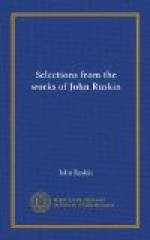[Sidenote: Death in 1900.]
It is needless to follow the broken author through the desolation of his closing years to his death in 1900. Save for his charming reminiscences, Praeterita, his work was done; the long struggle was over, the struggle of one man to reduce the complexities of a national life to an apostolic simplicity, to make it beautiful and good,
Till the high God behold it
from beyond,
And enter it.
[1] Praeterita. He was born February 8, 1819.
[2] Ruskin himself quotes a not very brilliant
specimen in Modern
Painters, III, in “Moral of
Landscape.”
[3] Praeterita, Sec. 53.
[4] The Mystery of Life.
II
THE UNITY OF RUSKIN’S WRITINGS
[Sidenote: Diversity of his writings.]
Ruskin is often described as an author of bewildering variety, whose mind drifted waywardly from topic to topic—from painting to political economy, from architecture to agriculture—with a license as illogical as it was indiscriminating. To this impression, Ruskin himself sometimes gave currency. He was, for illustration, once announced to lecture on crystallography, but, as we are informed by one present,[5] he opened by asserting that he was really about to lecture on Cistercian architecture; nor did it greatly matter what the title was; “for,” said he, “if I had begun to speak about Cistercian abbeys, I should have been sure to get on crystals presently; and if I had begun upon crystals, I should soon have drifted into architecture.” Those who conceive of Ruskin as being thus a kind of literary Proteus like to point to the year 1860, that of the publication of his tracts on economics, as witnessing the greatest and suddenest of his changes, that from reforming art to reforming society; and it is true that this year affords a simple dividing-line between Ruskin’s earlier work, which is sufficiently described by the three titles, Modern Painters, The Seven Lamps of Architecture, and The Stones of Venice, and his later work, chiefly on social subjects such as are discussed in Unto This Last, The Crown of Wild Olive, and Fors Clavigera. And yet we cannot insist too often on the essential unity of this work, for, viewed in the large, it betrays one continuous development. The seeds of Fors are in The Stones of Venice.
[Sidenote: Underlying idea in all his works.]
The governing idea of Ruskin’s first published work, Modern Painters, Volume I, was a moral idea. The book was dedicated to the principle that that art is greatest which deals with the greatest number of greatest ideas,—those, we learn presently, which reveal divine truth; the office of the painter, we are told,[6] is the same as that of the preacher, for “the duty of both is to take for each discourse one essential truth.”




